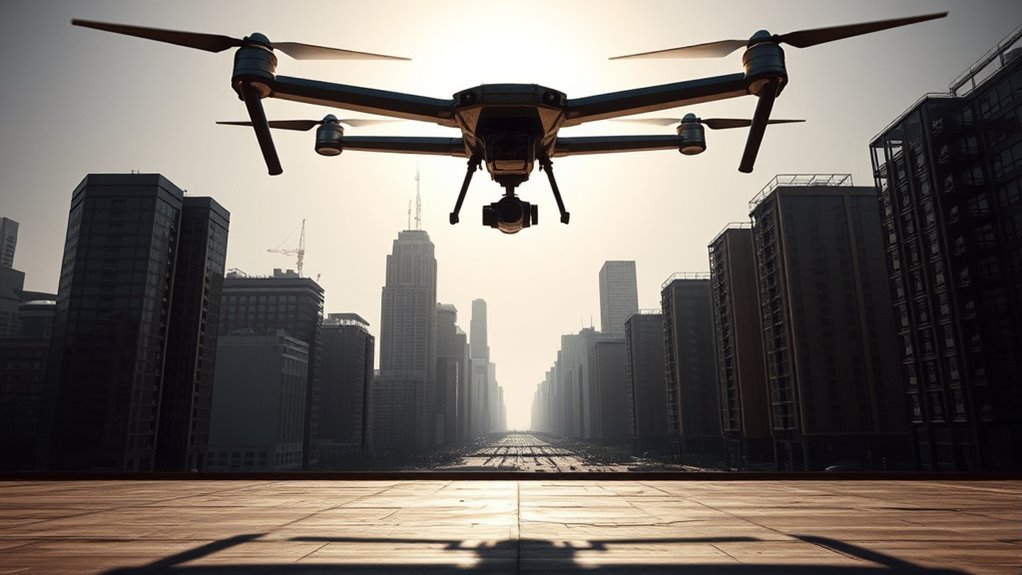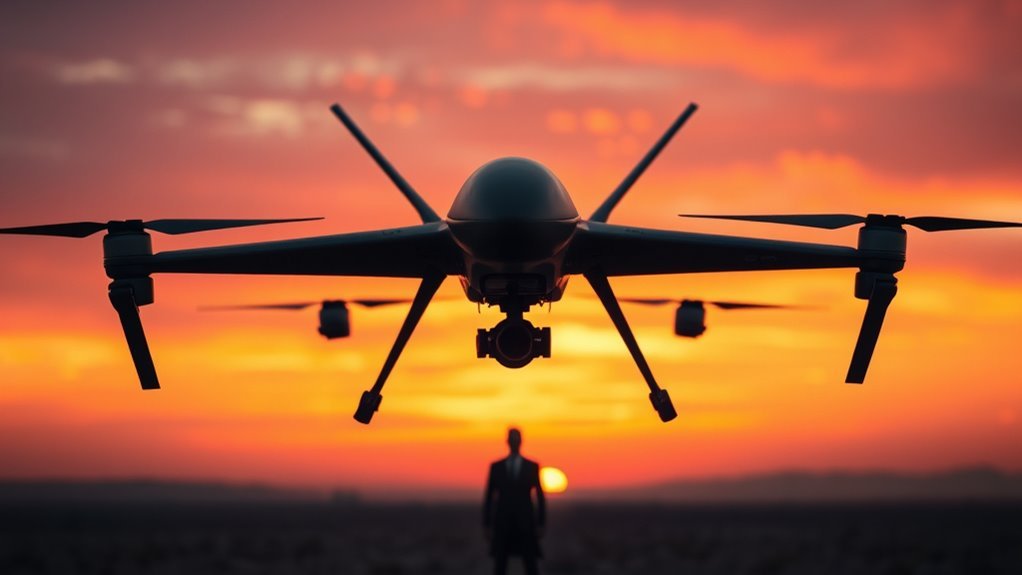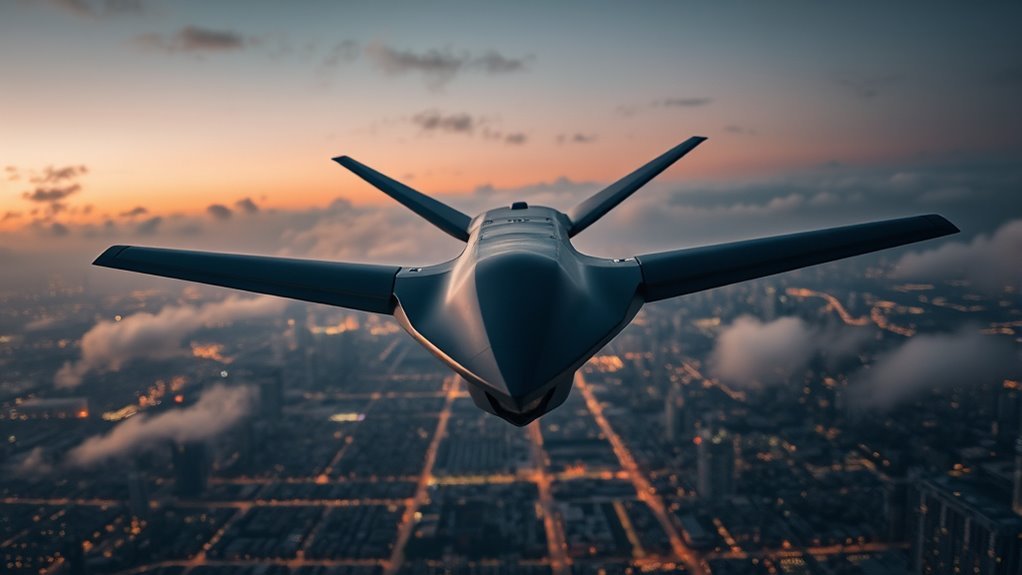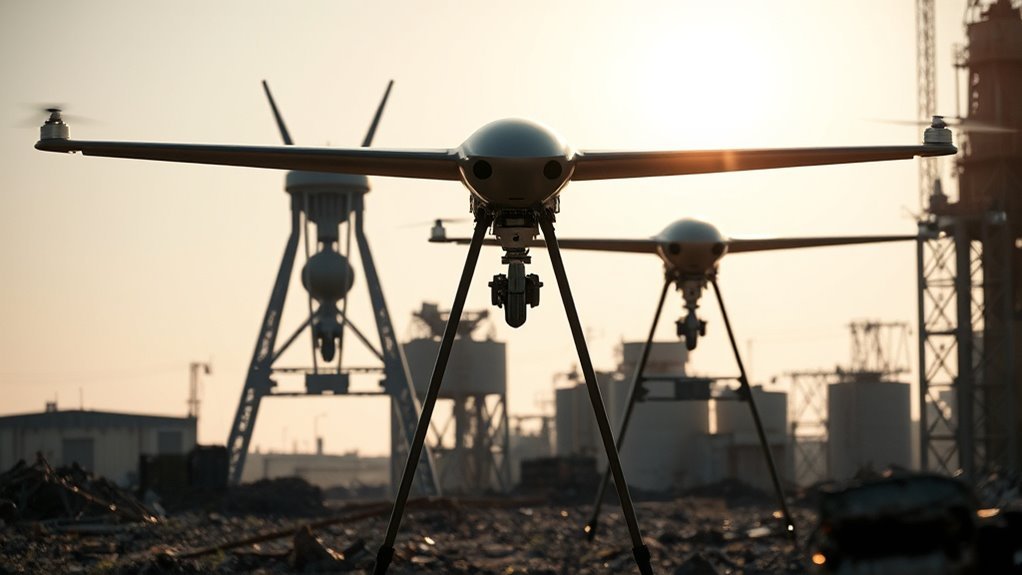Murder drones vary widely in height, typically ranging from smaller models with a wingspan of 1-2 feet to larger platforms that can exceed 20 feet. This size affects their operational capabilities, including maneuverability and payload capacity. Smaller drones excel in urban environments, while larger drones are suited for extensive missions. Understanding the height dimensions of murder drones is essential for evaluating their tactical applications. There’s much more to uncover about their design and impact on warfare.
The Definition of Murder Drones

Murder drones, a term that evokes both intrigue and concern, refer to unmanned aerial vehicles (UAVs) specifically designed for lethal operations. These advanced systems incorporate cutting-edge technology, enhancing their murder drone features such as autonomous navigation, surveillance capabilities, and precision targeting. The integration of artificial intelligence allows for real-time decision-making, markedly improving combat efficiency. You’d find that these drones employ sophisticated algorithms to assess threats and optimize strike accuracy, minimizing collateral damage. This development raises critical ethical and strategic questions about warfare and the implications for personal freedoms. As you consider the impact of such technology, it’s essential to balance the pursuit of security with the preservation of human rights, ensuring that advancements don’t infringe upon the values you hold dear.
Typical Dimensions of Combat Drones

Combat drones typically range in size from small, portable models to larger, more sophisticated platforms, with dimensions often dictated by their intended mission profiles. For instance, small drones might measure around 1-2 feet in wingspan, ideal for reconnaissance and rapid deployment. In contrast, larger combat drones can exceed 20 feet, designed for extensive payloads and advanced drone technology. Their dimensions greatly impact combat strategies, influencing maneuverability, stealth, and operational range. A drone’s size directly correlates to its performance capabilities, dictating how it engages targets or collects intelligence. Understanding these dimensions is essential for military planners aiming to optimize their fleets for various missions while maintaining the flexibility that modern warfare demands.
Factors Influencing Drone Height

Although various technical specifications and mission requirements play critical roles, several key factors greatly influence the height of drones. The interplay of drone technology and altitude effects can determine operational efficiency. Here’s a concise overview of these factors:
| Factor | Description |
|---|---|
| Payload Capacity | Higher altitude may affect carrying capacity. |
| Aerodynamics | Design influences ideal flight height. |
| Mission Objectives | Reconnaissance vs. strike missions vary. |
| Environmental Conditions | Weather and air pressure impact altitude. |
| Regulatory Restrictions | Laws may dictate maximum operational heights. |
Understanding these elements helps in choosing the appropriate drone height for specific tasks while ensuring freedom of operation in various environments.
Comparison of Drone Heights Across Models
When comparing the heights of various murder drone models, you’ll notice significant variations linked to their specifications. Each model is designed with specific operational requirements that influence its overall height, impacting maneuverability and payload capacity. Understanding these differences is essential for evaluating their effectiveness in various scenarios.
Murder Drones Specifications
The varying heights of Murder Drones across different models reveal significant differences in design and functionality. Each model’s height is intricately linked to its intended purpose, affecting its combat capabilities and maneuverability. For instance, smaller drones often excel in urban environments, utilizing advanced drone technology to navigate tight spaces, while larger drones typically possess enhanced payload capacity.
The height specifications dictate not only the drone’s agility but also its operational range, influencing how effectively it can engage targets. Understanding these specifications is essential for evaluating their effectiveness in various missions. Ultimately, the choice of a specific model reflects a balance between size, combat capabilities, and the tactical requirements of the operation at hand.
Height Variations Among Models
Height variations among Murder Drone models greatly impact their operational capabilities, influencing everything from mobility to mission effectiveness. Understanding these height measurements helps you appreciate the design innovations that drive each model’s purpose.
| Model | Height Measurement (cm) |
|---|---|
| Phantom X1 | 120 |
| Specter S2 | 150 |
| Vortex V3 | 180 |
| Wraith W4 | 210 |
As you can see, each model’s height directly correlates to its intended use. Shorter drones like the Phantom X1 excel in agility, while taller models like the Wraith W4 provide enhanced payload capacity. These variations enable you to select the right drone for specific missions, emphasizing the importance of understanding height in operational effectiveness.
Impact of Height on Drone Performance
As drone operations ascend to higher altitudes, their performance metrics undergo significant alterations. You’ll notice that altitude effects can drastically influence the drone’s agility. At elevated heights, the thinner atmosphere reduces drag, potentially enhancing speed and maneuverability. However, this same reduction in air density can impair lift efficiency, making it harder for drones to maintain stable flight.
You’ll also find that control responsiveness might diminish, as the drone’s motors work harder to compensate for lower thrust. Consequently, while higher altitudes may offer a tactical advantage in visibility, they can also challenge your drone’s operational efficiency. Understanding these complexities is essential for optimizing performance and ensuring that your drone meets its mission objectives effectively in varying heights.
The Role of Height in Tactical Advantages
Height plays a critical role in enhancing visibility, allowing operators to survey larger areas while minimizing exposure to ground threats. This elevation not only improves maneuverability during combat but also leverages psychological tactics to instill fear in adversaries. By understanding these dynamics, you can better appreciate the strategic advantages that height provides in drone operations.
Height and Visibility Impact
When evaluating the tactical advantages of murder drones, one cannot overlook how altitude greatly influences visibility and operational effectiveness. Height benefits play an essential role in conducting a thorough visibility analysis. Operating from elevated positions allows drones to survey vast areas, enhancing their situational awareness and target acquisition capabilities. This increased altitude not only minimizes the chance of detection but also provides an extensive perspective on potential threats and strategic opportunities. Consequently, the ability to maintain altitude during operations empowers operators with vital intelligence, enabling them to make informed decisions swiftly. Ultimately, understanding the relationship between height and visibility can lead to significant advantages in combat scenarios, ensuring that tactical superiority is achieved while preserving operational security.
Maneuverability in Combat
While altitude provides a strategic advantage in visibility, it also greatly enhances maneuverability in combat scenarios. Height allows for superior tactical positioning, enabling you to exploit aerial agility and stealth capabilities effectively. This combination can turn the tide in confrontations, offering several distinct benefits:
- Increased evasion from ground-based threats
- Enhanced ability to execute complex aerial maneuvers
- Greater reach for reconnaissance and targeting
- Improved response time to dynamic battlefield conditions
- Capacity to outflank opponents from above
Incorporating these elements into your combat strategy guarantees a more adaptable approach, allowing you to leverage your drone’s height for maximum impact. Ultimately, altitude isn’t just about seeing further; it’s about moving smarter in the heat of battle.
Psychological Warfare Tactics
By leveraging altitude, you can greatly enhance the psychological impact of your drone operations on adversaries. Height provides a distinct tactical advantage, creating an overwhelming sense of drone intimidation. When drones operate from elevated positions, they not only gain superior visibility but also instill fear, as enemies perceive them as omnipresent threats. This psychological warfare tactic can destabilize opponents, leading to hesitance and poor decision-making under pressure. The constant awareness of height adds an element of dread, potentially causing panic and disarray within enemy ranks. Moreover, the mere sight of drones soaring above can undermine morale, making the adversary question their own capabilities. Essentially, height transforms drones into formidable instruments of psychological dominance in modern warfare.
Future Trends in Drone Design
As technology advances at an unprecedented pace, the future of drone design is poised for transformative changes that will enhance their capabilities and applications. You’ll likely see a shift towards innovative features, thanks to future drone technology and advanced materials. Here’s what to expect:
- Increased Autonomy: Drones will operate with minimal human intervention, using AI for smarter decision-making.
- Lightweight Design: Advanced materials will make drones more durable yet lighter, improving maneuverability.
- Energy Efficiency: New power sources and designs will extend flight times considerably.
- Enhanced Payload Capacity: Future drones will carry more, allowing for diverse applications.
- Improved Stealth: Design enhancements will reduce detection, making drones less noticeable in operations.
Moreover, AI’s role in predictive maintenance will ensure that drones remain operational and efficient by anticipating potential failures before they occur.
These trends promise to revolutionize how drones interact with the world.
Ethical Considerations of Drone Warfare
The rapid advancements in drone technology, particularly regarding autonomy and payload capacity, raise significant ethical considerations in the domain of warfare. You have to reflect on the ethical implications of utilizing drones that can operate with minimal human oversight. This autonomy could challenge traditional combat ethics, as it blurs the lines of accountability and responsibility for actions taken in conflict zones. When drones make life-and-death decisions, the potential for errors increases, leading to unintended civilian casualties. In addition, the detachment provided by remote warfare may desensitize operators to the realities of combat, undermining the moral weight of their decisions. As you ponder these developments, it’s essential to advocate for ethical frameworks that prioritize human oversight and accountability in drone warfare to uphold the principles of just conflict.
Frequently Asked Questions
What Materials Are Commonly Used in Constructing Murder Drones?
When constructing drones, you’ll find materials like lightweight composites and metals. Advanced construction techniques guarantee durability and precision, allowing for enhanced maneuverability and efficiency in various operational contexts, ultimately optimizing performance and adaptability in the field.
How Do Weather Conditions Affect Murder Drone Operations?
Weather impacts drone performance considerably. Rain, wind, and temperature variations can reduce stability, battery efficiency, and navigation accuracy. Understanding these factors is essential for optimizing operations and ensuring effective mission execution in varying environmental conditions.
What Is the Average Weight of Murder Drones?
When weighing the essence of efficiency, consider that murder drones typically average around 400 to 500 pounds. Their drone specifications and payload capacity allow for varied operational capabilities, enhancing their effectiveness in complex environments.
Can Murder Drones Be Equipped With Non-Lethal Technology?
You can explore non-lethal alternatives for murder drones, but ethical considerations arise. Balancing technology’s capabilities with humane applications is essential, ensuring these devices serve constructive purposes without escalating violence or infringing on personal freedoms.
What Is the Typical Flight Range of Murder Drones?
When evaluating the typical flight range of murder drones, you’ll find their flight capabilities often extend several kilometers, though operational limits can vary based on design, payload, and environmental factors affecting performance and endurance.

